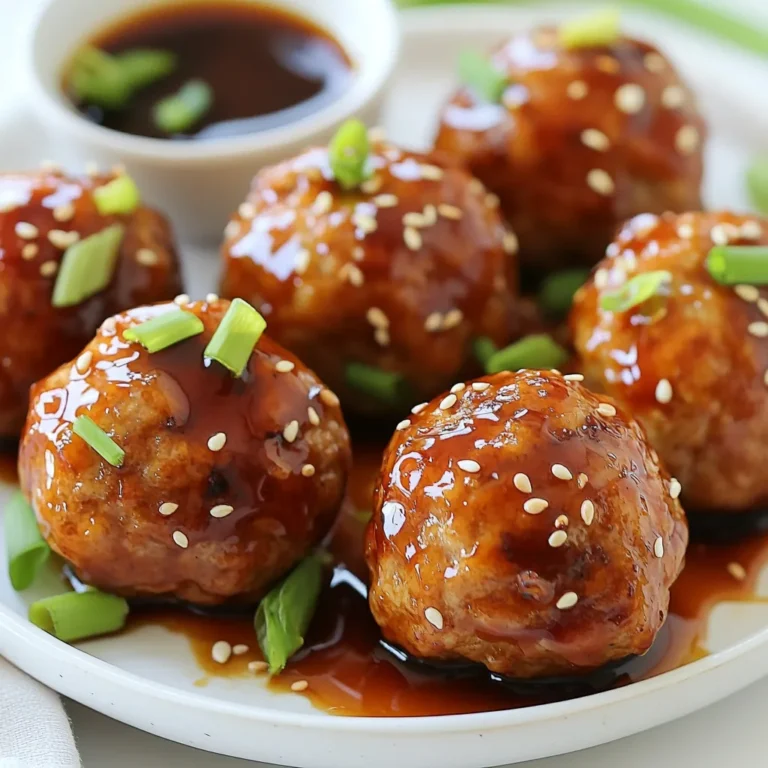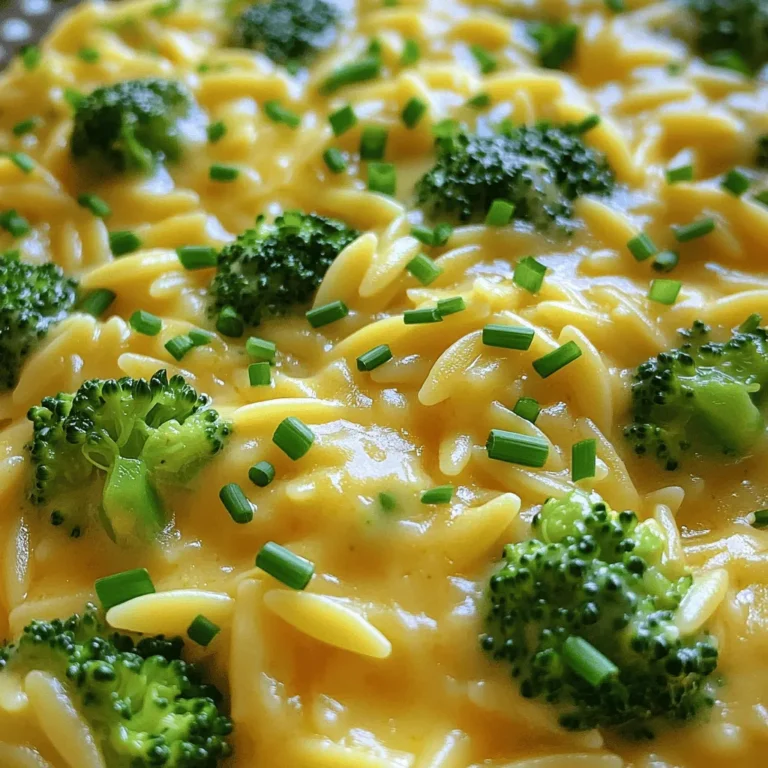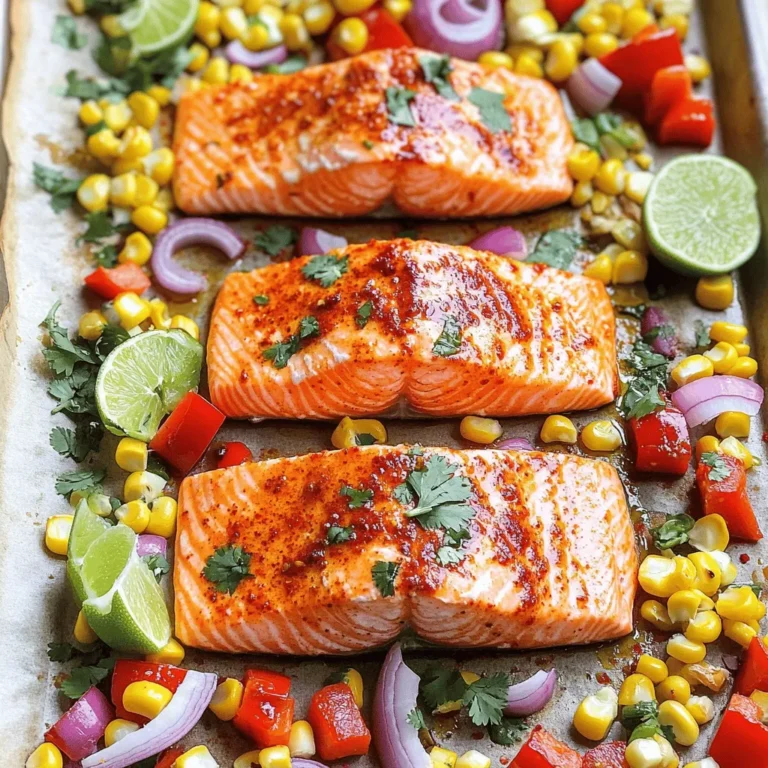Creamy Cauliflower Alfredo Easy and Healthy Recipe
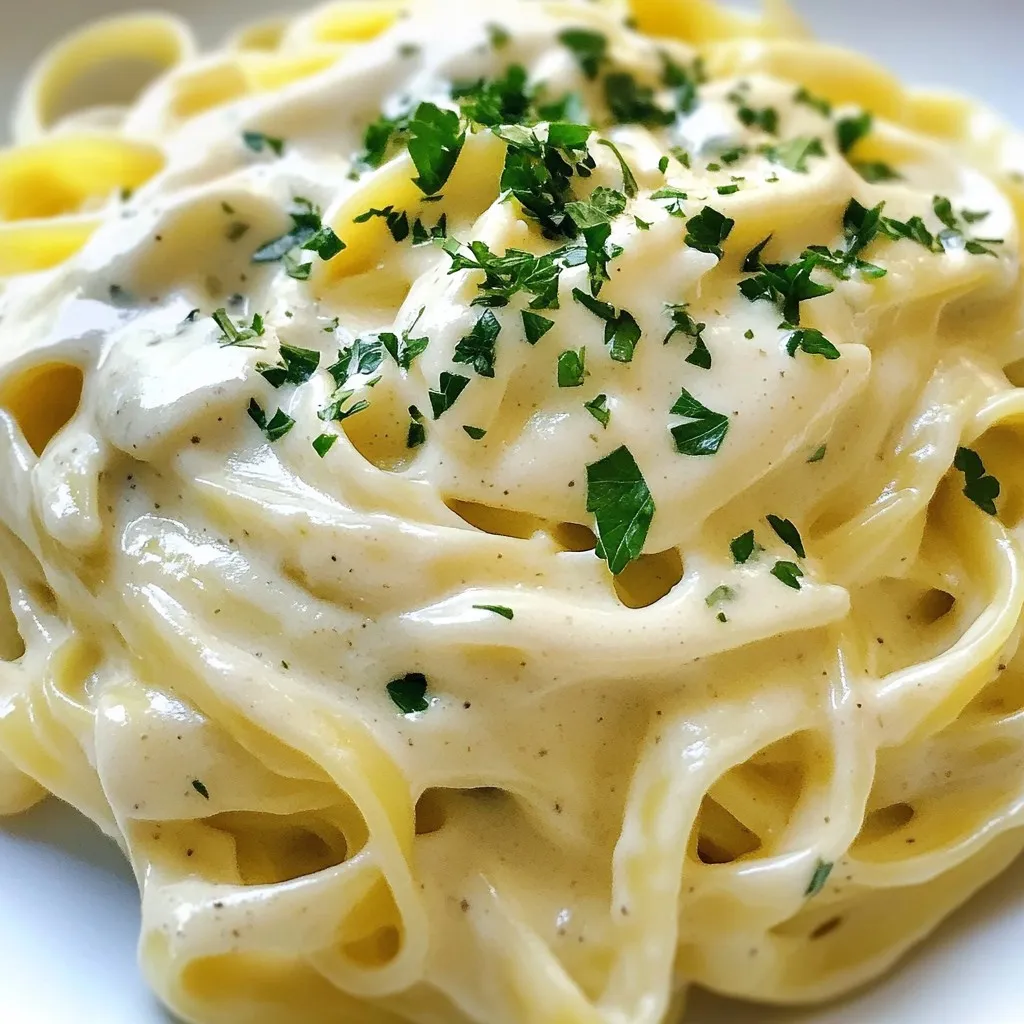
Looking for a healthier twist on a classic dish? My Creamy Cauliflower Alfredo recipe swaps heavy cream for tender cauliflower, giving you a rich, satisfying sauce that’s packed with flavor. With simple ingredients like garlic, olive oil, and almond milk, you can whip this up in no time. Perfect for busy weeknights or impressing guests, this recipe is sure to become a favorite. Let’s dive into how to make this delicious dish!
Why I Love This Recipe
- Healthier Alternative: This creamy cauliflower Alfredo sauce is a lighter take on traditional Alfredo, providing a deliciously rich flavor without the heavy cream.
- Flavor Packed: The combination of garlic, lemon juice, and nutritional yeast creates a savory depth that elevates the dish to restaurant-quality.
- Simple Ingredients: It uses simple, wholesome ingredients that are easy to find, making it perfect for weeknight dinners or meal prep.
- Versatile: This sauce is not just for fettuccine; it can be used with any pasta or even as a creamy base for vegetables and grains.
Ingredients
Main Ingredients
- Chopped cauliflower florets
- Extra virgin olive oil
- Minced garlic
- Vegetable broth
- Unsweetened almond milk
The main ingredients make this dish healthy and creamy. Chopped cauliflower florets serve as the base. They add nutrition and flavor. Extra virgin olive oil gives richness. Minced garlic adds a warm, savory taste. Vegetable broth enhances the overall flavor. Unsweetened almond milk brings creaminess without dairy.
Additional Seasonings
- Nutritional yeast
- Fresh lemon juice
- Onion powder
- Salt and pepper
These seasonings elevate your dish. Nutritional yeast gives a cheesy taste and is packed with nutrients. Fresh lemon juice adds brightness and balances the flavors. Onion powder brings depth. Salt and pepper enhance all the tastes, making every bite delicious.
Pasta Choices
- Fettuccine pasta
- Alternatives to fettuccine
Fettuccine pasta is the classic choice for this sauce. Its flat shape holds the creamy sauce well. You can use other pasta types, too. Try penne or spaghetti for a fun twist. No matter the pasta, the creamy cauliflower sauce will shine.
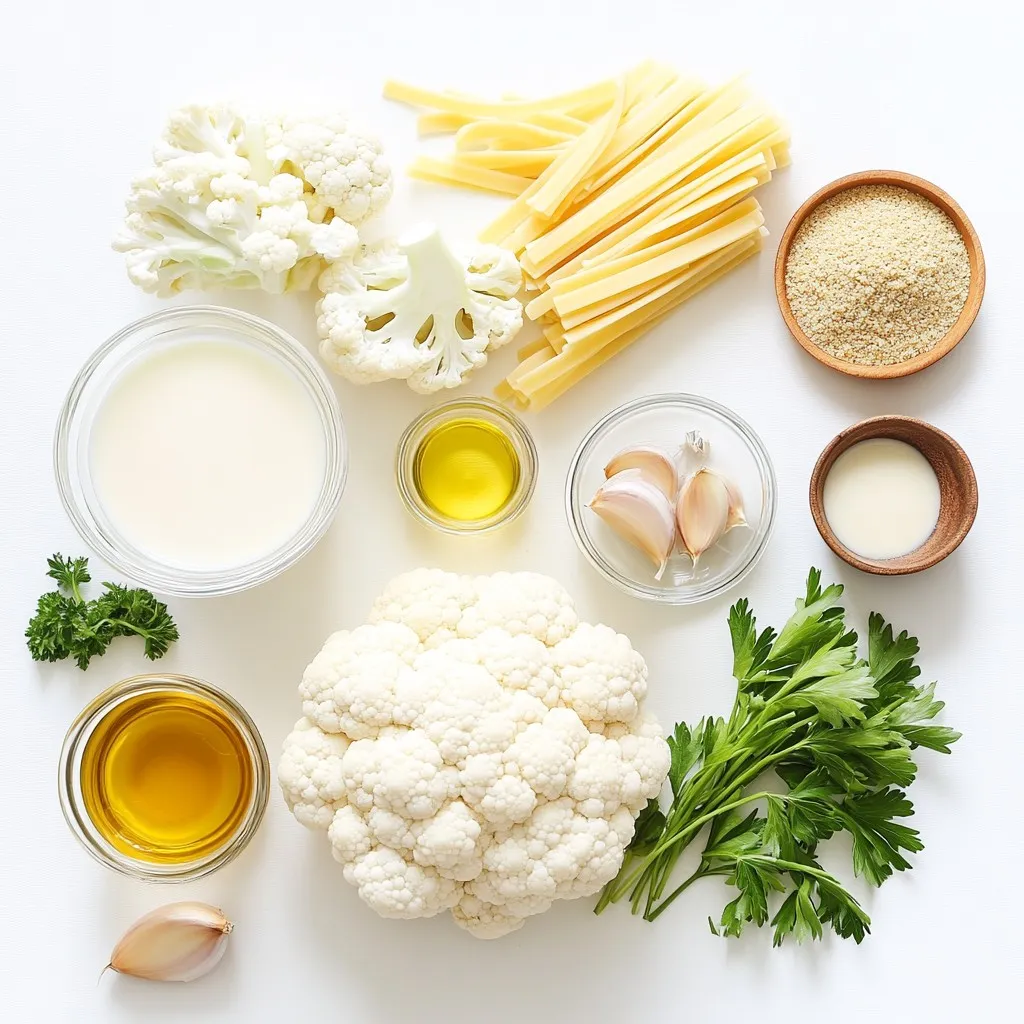
Step-by-Step Instructions
Cooking the Pasta
To start, fill a large pot with salted water. Bring it to a rolling boil. Add 1 pound of fettuccine. Stir occasionally to prevent sticking. Cook according to the package, usually about 8-10 minutes. When the pasta is al dente, drain it. Do not forget to save ½ cup of the starchy water. Set the pasta aside for now.
Preparing the Cauliflower
Next, take your medium head of cauliflower. Chop it into small florets. In a separate pot, combine these florets with 1 ½ cups of vegetable broth. Cover the pot and bring it to a boil. Once boiling, lower the heat. Let it simmer for about 10-12 minutes. Check if the cauliflower is fork-tender. If it is, you are ready to blend.
Blending the Sauce
After draining the cauliflower, place it in a high-speed blender. Add 2 tablespoons of extra virgin olive oil, 3 minced garlic cloves, and ½ cup of unsweetened almond milk. Also, include ½ cup of nutritional yeast, 2 tablespoons of fresh lemon juice, and 1 teaspoon of onion powder. Season with salt and pepper. Blend until smooth and creamy. If the sauce is too thick, add some reserved pasta water to reach your desired consistency.
Combining Pasta and Sauce
In a large mixing bowl, add the cooked fettuccine. Pour the creamy cauliflower sauce over the pasta. Toss everything gently. Make sure every strand of pasta is well-coated with the sauce.
Serving and Garnishing
Now it’s time to serve. Dish the creamy pasta onto plates or in bowls. For a pop of color and flavor, sprinkle freshly chopped parsley on top. You can also add a dash of nutritional yeast for extra flavor. For a fun presentation, twirl the fettuccine into nests before serving. Enjoy your delicious meal!
Tips & Tricks
Making the Sauce Creamier
To make your sauce even creamier, try adding a bit of cashew cream. Blend soaked cashews with water for a rich texture. You can also mix in some vegan cream cheese for a velvety touch.
For perfect blending, use a high-speed blender. Blend the cauliflower mixture until it’s fully smooth. If needed, scrape down the sides to ensure everything gets blended well.
Flavor Enhancements
To boost flavor, add spices like nutmeg or smoked paprika. These spices bring warmth and depth to the dish. Fresh herbs like thyme or basil can brighten the taste.
Always taste your sauce while mixing. You can add more salt or a splash of lemon juice to enhance flavors. Don’t be afraid to experiment with different seasonings.
Cooking Time Optimization
While your cauliflower cooks, multitask by boiling the pasta. This saves time and keeps everything warm. Keep an eye on both to ensure they finish at the same time.
If you’re short on time, use a pressure cooker for the cauliflower. Cook it for just 5 minutes under high pressure. This method speeds up cooking and locks in flavors.
Pro Tips
- Cooking Cauliflower: Steam the cauliflower instead of boiling it to retain more nutrients and flavor.
- Adjusting Consistency: If the sauce is too thick, add more vegetable broth or almond milk gradually until you reach your desired creaminess.
- Flavor Enhancements: Experiment with adding a pinch of nutmeg or smoked paprika for a unique twist on the classic Alfredo flavor.
- Serving Suggestions: Serve with a sprinkle of red pepper flakes for a touch of heat and extra flavor.

Variations
Vegan Alternatives
You can easily make this dish vegan. Use plant-based cream instead of almond milk. For added flavor, add cashew cream or coconut milk. Nutritional yeast already gives a cheesy taste, but feel free to add more. For protein, add chickpeas or tofu. They blend well with the sauce and add nutrition.
Gluten-Free Options
If you need a gluten-free dish, choose gluten-free pasta. Brands like brown rice or quinoa pasta work well. For the sauce, it’s already gluten-free, but always check ingredients. You can adjust the seasoning to match your taste. This makes it safe for those with gluten sensitivity.
Flavor Variations
Want to change up the flavor? Add spinach or peas to the sauce for extra veggies. Try mushrooms or bell peppers for a different taste. If you like meat, shrimp or grilled chicken work great too. Just cook them separately and mix them in before serving.
Storage Info
Refrigerator Storage
Store leftovers in an airtight container. Make sure the container is sealed well. This keeps the Alfredo sauce fresh and tasty. I recommend eating it within 3 to 4 days.
Freezing the Sauce
To freeze the sauce, let it cool first. Pour it into freezer-safe bags or containers. Squeeze out as much air as possible before sealing. This helps prevent freezer burn. You can freeze the sauce for up to 3 months.
When you’re ready to use it, thaw the sauce in the fridge overnight. You can also use the microwave on low power to speed up thawing.
Reheating Tips
To reheat without losing texture, stovetop is best. Heat it gently in a pan over low heat. Stir often and add a splash of almond milk if it thickens.
You can use the microwave too. Heat in short bursts and stir between each. This avoids hot spots and keeps the sauce creamy.
FAQs
Can I use frozen cauliflower?
Yes, you can use frozen cauliflower. Just rinse it under cold water. This helps remove ice crystals. Then, cook it for a shorter time. Frozen cauliflower usually cooks faster. Aim for about 8-10 minutes in the broth until tender. Blend it the same way as fresh.
What can I substitute for nutritional yeast?
You can use grated Parmesan cheese or ground cashews. Both will add a nice flavor. Parmesan gives a cheesy taste, while cashews add creaminess. If you want a nut-free option, try using a bit of miso paste. It will change the flavor a bit but still taste great.
Is this recipe customizable?
Absolutely! You can change the pasta type. Use gluten-free pasta or zoodles. You can also add veggies like spinach or mushrooms for extra nutrients. For more protein, toss in cooked chicken or chickpeas. The sauce can also be spiced up with red pepper flakes or herbs.
How long does this dish keep?
In the fridge, this dish lasts about 3-5 days. Store it in an airtight container. If you see any mold or smell something off, it’s best to toss it. You can also store the sauce separately from the pasta for better freshness.
Can I make this sauce in advance?
Yes, you can make the sauce ahead of time. Let it cool and store it in the fridge. It will keep well for up to 3 days. When you’re ready to use, just reheat it on low heat. Add a splash of almond milk to help with creaminess.
This blog post detailed how to make a creamy cauliflower pasta dish. We covered the main ingredients like cauliflower and garlic, plus all the seasonings that enhance the flavor. I shared step-by-step instructions from cooking the pasta to mixing in the sauce. You learned tips for making the sauce creamier and how to store leftovers.
Remember, cooking is about learning and having fun. Try different variations to make this recipe your own! Enjoy your time in the kitchen and happy cookin
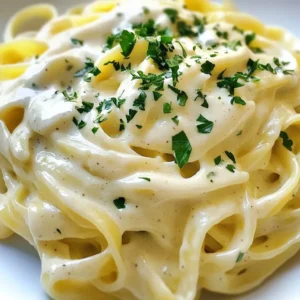
Dreamy Creamy Cauliflower Alfredo
Ingredients
- 1 medium head cauliflower, chopped into florets
- 2 tablespoons extra virgin olive oil
- 3 cloves garlic, minced
- 1.5 cups vegetable broth
- 0.5 cup unsweetened almond milk
- 0.5 cup nutritional yeast
- 2 tablespoons fresh lemon juice
- 1 teaspoon onion powder
- to taste salt and pepper
- 1 pound fettuccine pasta (or pasta of your choice)
- for garnish fresh parsley, finely chopped
Instructions
- In a large pot, fill with salted water and bring to a vigorous boil. Add the fettuccine, stirring occasionally until al dente, following the package instructions (usually about 8-10 minutes). Once cooked, drain the pasta but reserve ½ cup of the starchy pasta water for later use. Set the cooked fettuccine aside.
- In a separate pot, combine the chopped cauliflower with the vegetable broth. Cover the pot and bring to a boil, then reduce the heat and let it simmer. Cook until the cauliflower is fork-tender, approximately 10-12 minutes.
- After draining the cauliflower, transfer it to a high-speed blender. Add the olive oil, minced garlic, almond milk, nutritional yeast, lemon juice, onion powder, and a pinch of salt and pepper. Blend on high until the mixture is silky smooth and creamy. If the sauce appears too thick, gradually incorporate the reserved pasta water until the desired consistency is reached.
- Taste the creamy sauce and adjust seasonings as necessary; add more salt, pepper, or a splash of lemon juice to elevate the flavor to your liking.
- In a large mixing bowl, introduce the cooked fettuccine to the creamy cauliflower sauce. Toss gently but thoroughly to ensure each strand of pasta is luxuriously coated with the sauce.
- Dish out the pasta onto plates or into bowls, garnishing generously with freshly chopped parsley for added vibrancy and flavor.

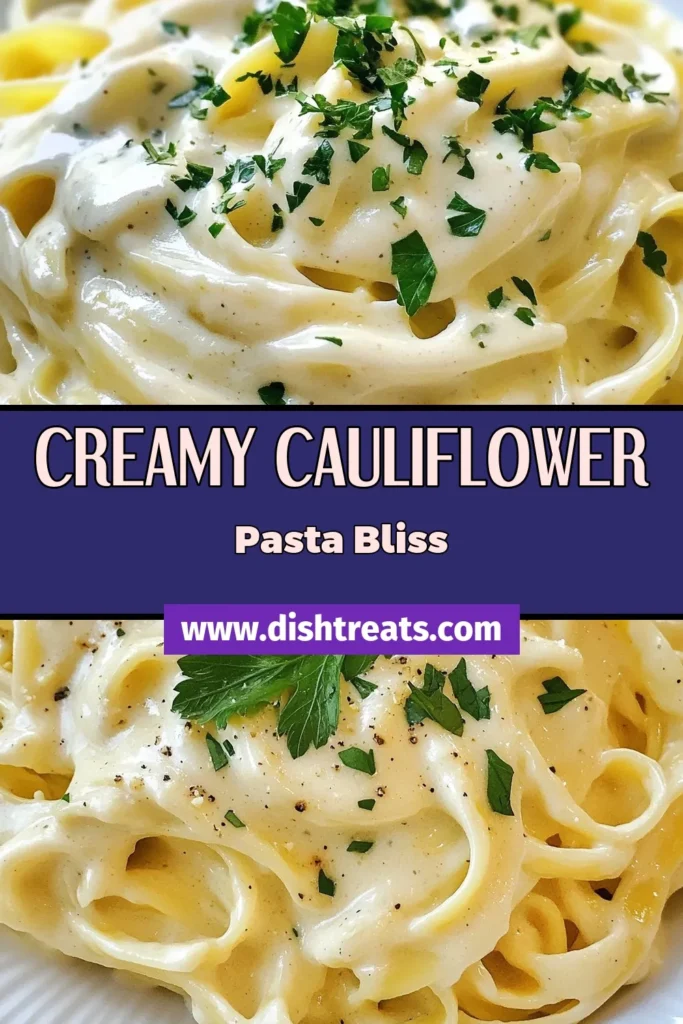
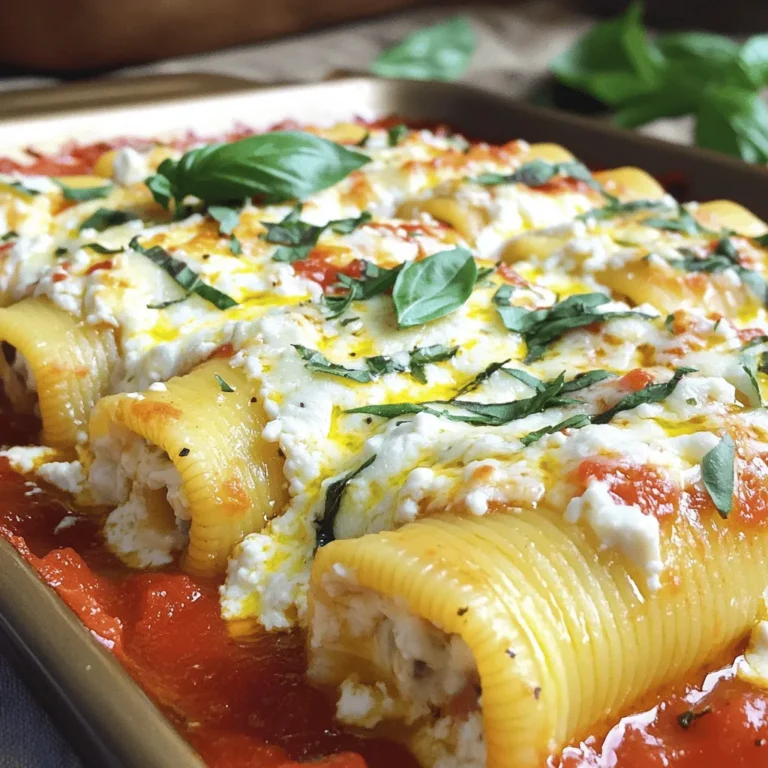
![- 4 chicken thighs (bone-in, skin-on) - 2 tablespoons jerk seasoning - 1 tablespoon olive oil - Salt and pepper to taste - 1 ripe pineapple, peeled and diced into small cubes - 1 red bell pepper, diced into small pieces - 1 small red onion, finely chopped - 1 jalapeño, deseeded and minced (adjust for spice preference) - Juice of 1 fresh lime - Fresh cilantro, chopped (for garnish) For this jerk chicken with pineapple salsa recipe, use chicken thighs for their rich flavor. The jerk seasoning adds a spicy and smoky kick. The pineapple and vegetables bring freshness and sweetness to the dish. - Adjust spice levels: If you want less heat, skip the jalapeño or use less jerk seasoning. - Additional garnishes: Lime wedges and extra cilantro make great toppings. You can also add avocado for creaminess. Feel free to customize these ingredients according to your taste. The key is to balance heat, sweetness, and freshness. For the full recipe, check out the [Full Recipe]. Start by mixing the chicken thighs with jerk seasoning, olive oil, salt, and pepper. Use your hands to coat each piece well. This step is key for flavor. Cover the bowl with plastic wrap and place it in the fridge. Marinate for at least 1 hour, but overnight gives the best taste. In a clean bowl, combine diced pineapple, red bell pepper, red onion, and jalapeño. Squeeze the juice of one lime over it and add a pinch of salt. Stir gently to mix. Let this salsa rest for at least 15 minutes. This resting time allows the flavors to blend nicely. Heat your grill or grill pan to medium-high. Take the chicken out of the marinade and let any extra drip off. Grill the chicken for about 6-8 minutes on each side. Use a meat thermometer to check that it reaches 165°F (75°C). This ensures it is fully cooked and safe to eat. Arrange the grilled jerk chicken on a platter. Spoon the bright pineapple salsa over the top. For a finishing touch, sprinkle fresh cilantro on the dish. You can also serve it on a rustic wooden board with lime wedges and extra pineapple chunks. This adds a fun, tropical vibe to your meal. For the full recipe, check out the [Full Recipe]. The key to great jerk chicken is marinating well. Many people rush this step, but a good marinating time is essential. Aim for at least one hour, or overnight if you can. This allows the chicken to soak up the flavors deeply. Common mistakes to avoid: - Skipping the marinade: This makes the chicken bland. - Using too much heat: Jerk seasoning has a kick. Balance it with other flavors. - Not resting the chicken: Skipping this step makes the meat dry. Flavor enhancements: - Add some lime zest to your marinade for extra tang. - Try a bit of honey for a hint of sweetness. - Use smoked paprika for a deeper, richer flavor. The salsa adds brightness to the dish. Choosing ripe pineapples is key to great flavor. Tips for selecting ripe pineapples: - Look for pineapples with a sweet smell at the base. - The skin should be golden and slightly firm. - Press gently; it should give just a little. Variations for additional flavor: - Add diced mango for extra sweetness. - Mix in some chopped mint for a fresh twist. - Try a dash of cumin for a warm, earthy note. These tips will help you create a jerk chicken dish that shines. Don't forget to check out the Full Recipe for more details! {{image_4}} You can swap chicken for other meats. Try pork or turkey. Both soak up jerk flavor well. If you prefer seafood, shrimp or fish works too. Just keep an eye on cooking times. Seafood cooks quickly, so grill it for just a few minutes. Feel free to play with the vegetables. You can use different peppers like green or yellow. Red onions are great, but sweet onions add a nice touch too. Want to mix it up? Add diced mango or avocado to the salsa. Fresh herbs like mint or basil can add fun flavors too. For gluten-free options, check your jerk seasoning. Make sure it has no gluten. You can enjoy jerk chicken without any worries. If you're looking for low-carb choices, skip the sugar in the salsa. You can also serve the chicken with a salad instead of rice. This keeps it fresh and light. To store leftovers, place the jerk chicken in an airtight container. Let it cool to room temperature before sealing. This helps keep it fresh longer. Jerk chicken can stay in the fridge for up to three days. When you are ready to eat, reheat it in the oven or on the grill. Heat it to 165°F (75°C) for safe eating. Avoid reheating in the microwave if you want crispy skin. Yes, you can freeze jerk chicken. Wrap it tightly in plastic wrap and then place it in a freezer-safe bag. It can last up to three months in the freezer. For thawing, move the chicken to the fridge overnight. If you need it fast, you can also use the microwave on the defrost setting. After thawing, make sure to heat it well before serving. This keeps it tasty and safe to eat. For the full recipe, visit the [Full Recipe]. I suggest marinating the chicken for at least one hour. For the best flavor, try to marinate overnight. This allows the jerk seasoning to soak in deeply, making the chicken tasty and juicy. Jerk chicken pairs well with a variety of sides. Some great options are: - Rice and peas - Grilled vegetables - Coleslaw - Fried plantains - Cornbread These sides balance the rich flavors of the chicken. Yes, you can make the salsa ahead of time. I recommend preparing it a few hours before serving. This gives the salsa time to rest. The flavors will mix better, making it even more delicious. Jerk seasoning has a unique and bold flavor. It combines heat from peppers, sweetness from spices, and a hint of smokiness. Common ingredients include allspice, thyme, and garlic. This mix creates a savory and vibrant taste. The spice level of jerk chicken can vary. It depends on the amount of jalapeño you use. If you want less heat, remove the seeds. For more spice, add extra jalapeño or a hotter pepper. Adjusting the seasoning lets you enjoy the dish at your preferred heat level. You learned about making jerk chicken with easy steps and key ingredients. Focus on marinating the chicken and crafting the pineapple salsa for the best flavor. Enjoy grilling techniques to get that perfect char. Remember to avoid common mistakes while cooking. You can also try different proteins and flavor swaps for variety. Store leftovers properly to enjoy later. Your jerk chicken can impress anyone at the table. Now, it’s time to put this knowledge to use and enjoy your delicious creation!](https://dishtreats.com/wp-content/uploads/2025/06/27cc5104-89a5-4e73-8f97-3d018bc709fa-768x768.webp)
